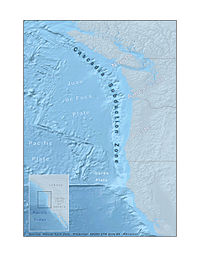
Photo from wikipedia
Previous studies have shown that plastic yielding in crustal rocks in the fault zone may impose a physical limit to extreme ground motions. We explore the effects of fault-zone non-linearity… Click to show full abstract
Previous studies have shown that plastic yielding in crustal rocks in the fault zone may impose a physical limit to extreme ground motions. We explore the effects of fault-zone non-linearity on peak ground velocities (PGVs) by simulating a suite of surface-rupturing strike-slip earthquakes in a medium governed by Drucker–Prager plasticity using the AWP-ODC finite-difference code. Our simulations cover magnitudes ranging from 6.5 to 8.0, three different rock strength models, and average stress drops of 3.5 and 7.0 MPa, with a maximum frequency of 1 Hz and a minimum shear-wave velocity of 500 m/s. Friction angles and cohesions in our rock models are based on strength criteria which are frequently used for fractured rock masses in civil and mining engineering. For an average stress drop of 3.5 MPa, plastic yielding reduces near-fault PGVs by 15–30% in pre-fractured, low strength rock, but less than 1% in massive, high-quality rock. These reductions are almost insensitive to magnitude. If the stress drop is doubled, plasticity reduces near-fault PGVs by 38–45% and 5–15% in rocks of low and high strength, respectively. Because non-linearity reduces slip rates and static slip near the surface, plasticity acts in addition to, and may partially be emulated by, a shallow velocity-strengthening layer. The effects of plasticity are exacerbated if a fault damage zone with reduced shear-wave velocities and reduced rock strength is present. In the linear case, fault-zone trapped waves result in higher near-surface peak slip rates and ground velocities compared to simulations without a low-velocity zone. These amplifications are balanced out by fault-zone plasticity if rocks in the damage zone exhibit low-to-moderate strength throughout the depth extent of the low-velocity zone ($$\sim$$∼5 km). We also perform dynamic non-linear simulations of a high stress drop (8 MPa) M 7.8 earthquake rupturing the southern San Andreas fault along 250 km from Indio to Lake Hughes. Non-linearity in the fault damage zone and in near-surface deposits would reduce peak ground velocities in the Los Angeles basin by 15–50%, depending on the strength of crustal rocks and shallow sediments. These results show that non-linear effects may be relevant even at long periods, in particular in earthquakes with high stress drop and in the presence of a low-velocity fault damage zone.
Journal Title: Pure and Applied Geophysics
Year Published: 2017
Link to full text (if available)
Share on Social Media: Sign Up to like & get
recommendations!